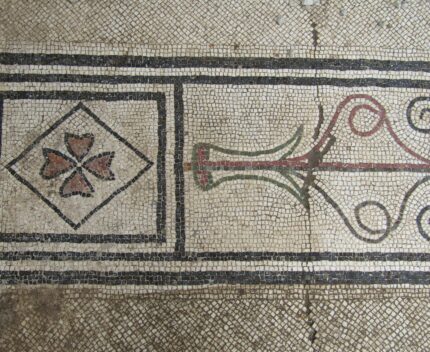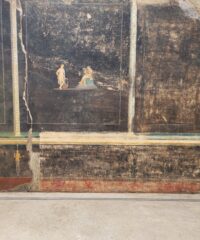 The excavation of insula 10 in Pompeii’s Regio IX neighborhood next to the recently-unearthed bakery has uncovered a banqueting hall with splendid wall frescoes depicting mythological characters and motifs from the Trojan War. Set against a solid black background are Paris and Helen, Apollo and Cassandra, and a supporting cast of maenads and satyrs acting almost as caryatids holding up the top register of the murals.
The excavation of insula 10 in Pompeii’s Regio IX neighborhood next to the recently-unearthed bakery has uncovered a banqueting hall with splendid wall frescoes depicting mythological characters and motifs from the Trojan War. Set against a solid black background are Paris and Helen, Apollo and Cassandra, and a supporting cast of maenads and satyrs acting almost as caryatids holding up the top register of the murals.
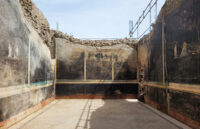 The oecus (banquet hall) is part of a large domus whose architectural style dates it to the middle of the 1st century B.C. It is 48 feet long and 20 feet wide, a huge room covering more than 950 square feet in area. A large window on the western wall let in the afternoon sun, although there was no garden or panoramic view of the gulf for diners to enjoy as there were in the banquet halls of some of the other wealthy homes in Pompeii. Instead, the window faced on to a small courtyard less than 12 feet deep bounded by the insula’s perimeter wall. Theoretically it could have had ornamental plants or some other attractive landscaping, but there’s a long staircase leading to a second floor at the end of the courtyard and stacks of construction material (tufa bricks, terracotta roof tiles, work tools, lime piles) are evidence that the villa was undergoing extensive renovation at the time of the cataclysmic eruption of Vesuvius in 79 A.D. So at least in its last days, the courtyard was a work site.
The oecus (banquet hall) is part of a large domus whose architectural style dates it to the middle of the 1st century B.C. It is 48 feet long and 20 feet wide, a huge room covering more than 950 square feet in area. A large window on the western wall let in the afternoon sun, although there was no garden or panoramic view of the gulf for diners to enjoy as there were in the banquet halls of some of the other wealthy homes in Pompeii. Instead, the window faced on to a small courtyard less than 12 feet deep bounded by the insula’s perimeter wall. Theoretically it could have had ornamental plants or some other attractive landscaping, but there’s a long staircase leading to a second floor at the end of the courtyard and stacks of construction material (tufa bricks, terracotta roof tiles, work tools, lime piles) are evidence that the villa was undergoing extensive renovation at the time of the cataclysmic eruption of Vesuvius in 79 A.D. So at least in its last days, the courtyard was a work site.
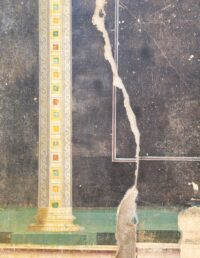 The decorated walls are frescoed in the Third Style, characterized by intricate details set against broad planes of monochromatic color. The high quality and literary references of the art represent the education, wealth and refinement of the residents, intended to impress their own friends and family rather than the clients who would have been received in their atrium. In addition to being fashionable, the black walls had the practical advantage of hiding the soot and smoke stains from the lamps that illuminated the banquet hall during post-sunset dinners. The flickering light of the lamps would give the illusion of life and movement to the vivid figures painted against the black background.
The decorated walls are frescoed in the Third Style, characterized by intricate details set against broad planes of monochromatic color. The high quality and literary references of the art represent the education, wealth and refinement of the residents, intended to impress their own friends and family rather than the clients who would have been received in their atrium. In addition to being fashionable, the black walls had the practical advantage of hiding the soot and smoke stains from the lamps that illuminated the banquet hall during post-sunset dinners. The flickering light of the lamps would give the illusion of life and movement to the vivid figures painted against the black background.
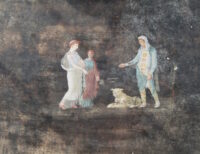 Paris and Helen (and one large dog whose expression suggests he knows this is not going to end well) adorn the north wall. They are labelled in Greek with their names ΑΛΕΞΑΝΔΡΟΣ ΕΛΕΝΗ (Alexandros, Paris’ birthname and Eleni). Paris wears a remarkable chiton decorated with gold buttons and bright squares of color that mimic the decoration of the pilasters dividing the central panels of the frescoed walls.
Paris and Helen (and one large dog whose expression suggests he knows this is not going to end well) adorn the north wall. They are labelled in Greek with their names ΑΛΕΞΑΝΔΡΟΣ ΕΛΕΝΗ (Alexandros, Paris’ birthname and Eleni). Paris wears a remarkable chiton decorated with gold buttons and bright squares of color that mimic the decoration of the pilasters dividing the central panels of the frescoed walls.
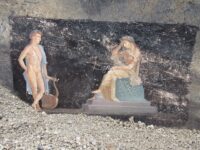 Apollo and Cassandra are on the south wall. Apollo is nude except for his blue and gold cape. Leaning against his lyre, the deity stares intently at a dubious-looking Cassandra seated across from him on the green omphalos enclosed in a gold net. She has her hand in her head and her expression is just as doubtful as Paris’ dog’s.
Apollo and Cassandra are on the south wall. Apollo is nude except for his blue and gold cape. Leaning against his lyre, the deity stares intently at a dubious-looking Cassandra seated across from him on the green omphalos enclosed in a gold net. She has her hand in her head and her expression is just as doubtful as Paris’ dog’s.
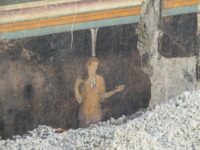 The top sections of the walls are separated by border bands in different columns (yellow, blue, green, brown, white). The panels are delimited vertically by faux pilasters. Below the borders on the bottom of the walls are the maenads standing on tripod stools, holding vessels in their outstretched hands and balancing stylized cones on their heads connected to the lowest of the bands.
The top sections of the walls are separated by border bands in different columns (yellow, blue, green, brown, white). The panels are delimited vertically by faux pilasters. Below the borders on the bottom of the walls are the maenads standing on tripod stools, holding vessels in their outstretched hands and balancing stylized cones on their heads connected to the lowest of the bands.
The long floor of the long room is still covered in a virtually intact mosaic of white tesserae with slim black borders. The thresholds to the adjacent antechamber are defined by polychrome red, blue, yellow and green mosaics of flowers inside circles, tendrilled palmettes and four-leaf clovers inside rhombuses.

